Occupational Therapy: Narrative Interview III - Hogan's Life Analysis
VerifiedAdded on 2019/09/30
|7
|2861
|168
Homework Assignment
AI Summary
This assignment analyzes a narrative interview with Mr. Hogan, focusing on his occupational life, resilience, and the impact of his experiences. The interview explores Hogan's life before and after an injury, including his family background, occupational roles, daily routines, occupational environment, and critical life events. The analysis highlights key themes such as resilience and family support, and identifies Hogan's primary motivators and valued roles. The assignment includes a breakdown of topical areas with supportive information, a reflective writing section summarizing key learnings, comparing the interview to another case study, and developing a theory based on the interview. The assignment covers Hogan's life from his childhood in Kansas City to his current daily routine, emphasizing his strong will, persistence, and desire to improve his work status and overall quality of life. The document provides a detailed overview of the interview process, Dr. Morrison's techniques, and Hogan's responses, offering a comprehensive understanding of his occupational journey and the factors shaping his current status.
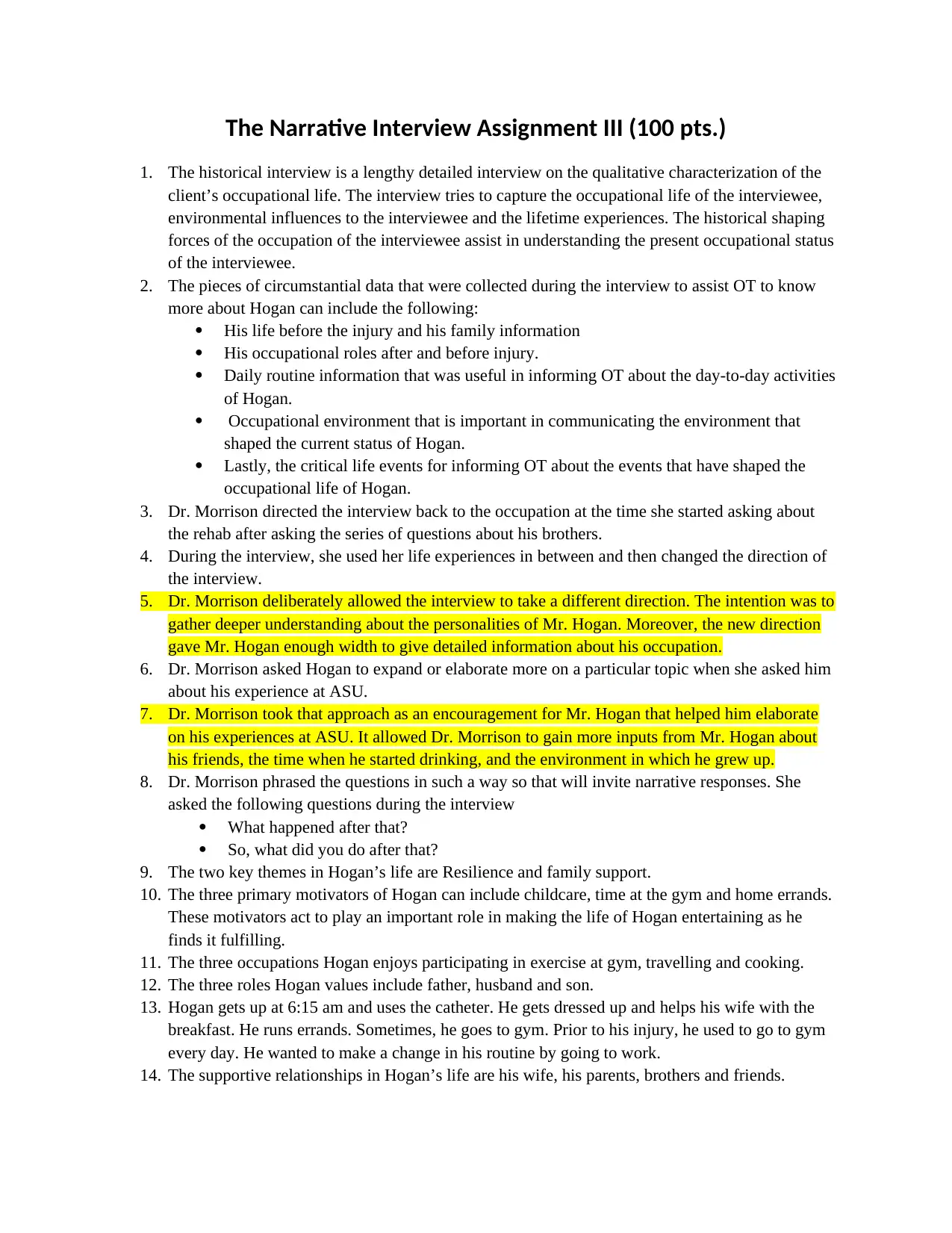
The Narrative Interview Assignment III (100 pts.)
1. The historical interview is a lengthy detailed interview on the qualitative characterization of the
client’s occupational life. The interview tries to capture the occupational life of the interviewee,
environmental influences to the interviewee and the lifetime experiences. The historical shaping
forces of the occupation of the interviewee assist in understanding the present occupational status
of the interviewee.
2. The pieces of circumstantial data that were collected during the interview to assist OT to know
more about Hogan can include the following:
His life before the injury and his family information
His occupational roles after and before injury.
Daily routine information that was useful in informing OT about the day-to-day activities
of Hogan.
Occupational environment that is important in communicating the environment that
shaped the current status of Hogan.
Lastly, the critical life events for informing OT about the events that have shaped the
occupational life of Hogan.
3. Dr. Morrison directed the interview back to the occupation at the time she started asking about
the rehab after asking the series of questions about his brothers.
4. During the interview, she used her life experiences in between and then changed the direction of
the interview.
5. Dr. Morrison deliberately allowed the interview to take a different direction. The intention was to
gather deeper understanding about the personalities of Mr. Hogan. Moreover, the new direction
gave Mr. Hogan enough width to give detailed information about his occupation.
6. Dr. Morrison asked Hogan to expand or elaborate more on a particular topic when she asked him
about his experience at ASU.
7. Dr. Morrison took that approach as an encouragement for Mr. Hogan that helped him elaborate
on his experiences at ASU. It allowed Dr. Morrison to gain more inputs from Mr. Hogan about
his friends, the time when he started drinking, and the environment in which he grew up.
8. Dr. Morrison phrased the questions in such a way so that will invite narrative responses. She
asked the following questions during the interview
What happened after that?
So, what did you do after that?
9. The two key themes in Hogan’s life are Resilience and family support.
10. The three primary motivators of Hogan can include childcare, time at the gym and home errands.
These motivators act to play an important role in making the life of Hogan entertaining as he
finds it fulfilling.
11. The three occupations Hogan enjoys participating in exercise at gym, travelling and cooking.
12. The three roles Hogan values include father, husband and son.
13. Hogan gets up at 6:15 am and uses the catheter. He gets dressed up and helps his wife with the
breakfast. He runs errands. Sometimes, he goes to gym. Prior to his injury, he used to go to gym
every day. He wanted to make a change in his routine by going to work.
14. The supportive relationships in Hogan’s life are his wife, his parents, brothers and friends.
1. The historical interview is a lengthy detailed interview on the qualitative characterization of the
client’s occupational life. The interview tries to capture the occupational life of the interviewee,
environmental influences to the interviewee and the lifetime experiences. The historical shaping
forces of the occupation of the interviewee assist in understanding the present occupational status
of the interviewee.
2. The pieces of circumstantial data that were collected during the interview to assist OT to know
more about Hogan can include the following:
His life before the injury and his family information
His occupational roles after and before injury.
Daily routine information that was useful in informing OT about the day-to-day activities
of Hogan.
Occupational environment that is important in communicating the environment that
shaped the current status of Hogan.
Lastly, the critical life events for informing OT about the events that have shaped the
occupational life of Hogan.
3. Dr. Morrison directed the interview back to the occupation at the time she started asking about
the rehab after asking the series of questions about his brothers.
4. During the interview, she used her life experiences in between and then changed the direction of
the interview.
5. Dr. Morrison deliberately allowed the interview to take a different direction. The intention was to
gather deeper understanding about the personalities of Mr. Hogan. Moreover, the new direction
gave Mr. Hogan enough width to give detailed information about his occupation.
6. Dr. Morrison asked Hogan to expand or elaborate more on a particular topic when she asked him
about his experience at ASU.
7. Dr. Morrison took that approach as an encouragement for Mr. Hogan that helped him elaborate
on his experiences at ASU. It allowed Dr. Morrison to gain more inputs from Mr. Hogan about
his friends, the time when he started drinking, and the environment in which he grew up.
8. Dr. Morrison phrased the questions in such a way so that will invite narrative responses. She
asked the following questions during the interview
What happened after that?
So, what did you do after that?
9. The two key themes in Hogan’s life are Resilience and family support.
10. The three primary motivators of Hogan can include childcare, time at the gym and home errands.
These motivators act to play an important role in making the life of Hogan entertaining as he
finds it fulfilling.
11. The three occupations Hogan enjoys participating in exercise at gym, travelling and cooking.
12. The three roles Hogan values include father, husband and son.
13. Hogan gets up at 6:15 am and uses the catheter. He gets dressed up and helps his wife with the
breakfast. He runs errands. Sometimes, he goes to gym. Prior to his injury, he used to go to gym
every day. He wanted to make a change in his routine by going to work.
14. The supportive relationships in Hogan’s life are his wife, his parents, brothers and friends.
Paraphrase This Document
Need a fresh take? Get an instant paraphrase of this document with our AI Paraphraser
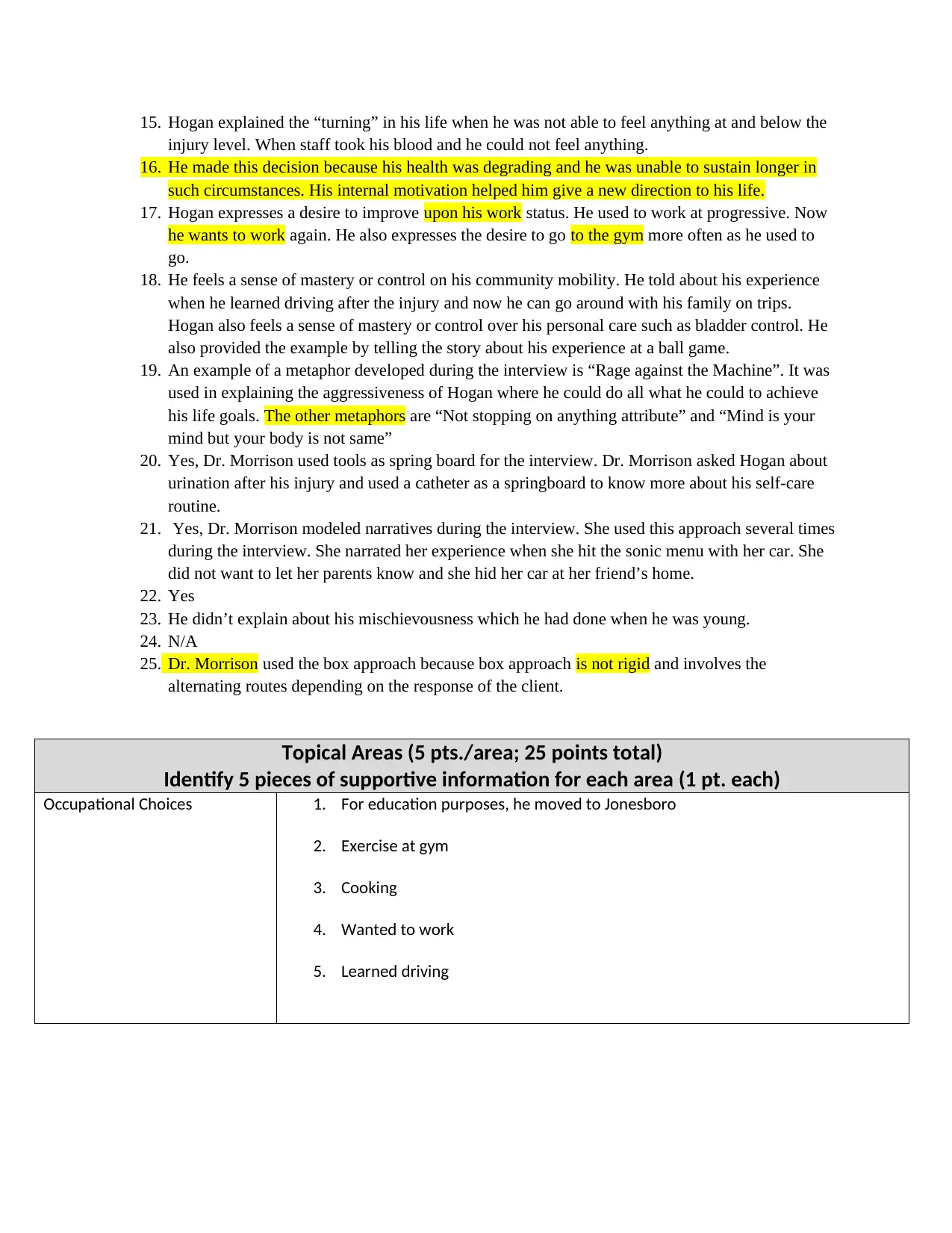
15. Hogan explained the “turning” in his life when he was not able to feel anything at and below the
injury level. When staff took his blood and he could not feel anything.
16. He made this decision because his health was degrading and he was unable to sustain longer in
such circumstances. His internal motivation helped him give a new direction to his life.
17. Hogan expresses a desire to improve upon his work status. He used to work at progressive. Now
he wants to work again. He also expresses the desire to go to the gym more often as he used to
go.
18. He feels a sense of mastery or control on his community mobility. He told about his experience
when he learned driving after the injury and now he can go around with his family on trips.
Hogan also feels a sense of mastery or control over his personal care such as bladder control. He
also provided the example by telling the story about his experience at a ball game.
19. An example of a metaphor developed during the interview is “Rage against the Machine”. It was
used in explaining the aggressiveness of Hogan where he could do all what he could to achieve
his life goals. The other metaphors are “Not stopping on anything attribute” and “Mind is your
mind but your body is not same”
20. Yes, Dr. Morrison used tools as spring board for the interview. Dr. Morrison asked Hogan about
urination after his injury and used a catheter as a springboard to know more about his self-care
routine.
21. Yes, Dr. Morrison modeled narratives during the interview. She used this approach several times
during the interview. She narrated her experience when she hit the sonic menu with her car. She
did not want to let her parents know and she hid her car at her friend’s home.
22. Yes
23. He didn’t explain about his mischievousness which he had done when he was young.
24. N/A
25. Dr. Morrison used the box approach because box approach is not rigid and involves the
alternating routes depending on the response of the client.
Topical Areas (5 pts./area; 25 points total)
Identify 5 pieces of supportive information for each area (1 pt. each)
Occupational Choices 1. For education purposes, he moved to Jonesboro
2. Exercise at gym
3. Cooking
4. Wanted to work
5. Learned driving
injury level. When staff took his blood and he could not feel anything.
16. He made this decision because his health was degrading and he was unable to sustain longer in
such circumstances. His internal motivation helped him give a new direction to his life.
17. Hogan expresses a desire to improve upon his work status. He used to work at progressive. Now
he wants to work again. He also expresses the desire to go to the gym more often as he used to
go.
18. He feels a sense of mastery or control on his community mobility. He told about his experience
when he learned driving after the injury and now he can go around with his family on trips.
Hogan also feels a sense of mastery or control over his personal care such as bladder control. He
also provided the example by telling the story about his experience at a ball game.
19. An example of a metaphor developed during the interview is “Rage against the Machine”. It was
used in explaining the aggressiveness of Hogan where he could do all what he could to achieve
his life goals. The other metaphors are “Not stopping on anything attribute” and “Mind is your
mind but your body is not same”
20. Yes, Dr. Morrison used tools as spring board for the interview. Dr. Morrison asked Hogan about
urination after his injury and used a catheter as a springboard to know more about his self-care
routine.
21. Yes, Dr. Morrison modeled narratives during the interview. She used this approach several times
during the interview. She narrated her experience when she hit the sonic menu with her car. She
did not want to let her parents know and she hid her car at her friend’s home.
22. Yes
23. He didn’t explain about his mischievousness which he had done when he was young.
24. N/A
25. Dr. Morrison used the box approach because box approach is not rigid and involves the
alternating routes depending on the response of the client.
Topical Areas (5 pts./area; 25 points total)
Identify 5 pieces of supportive information for each area (1 pt. each)
Occupational Choices 1. For education purposes, he moved to Jonesboro
2. Exercise at gym
3. Cooking
4. Wanted to work
5. Learned driving
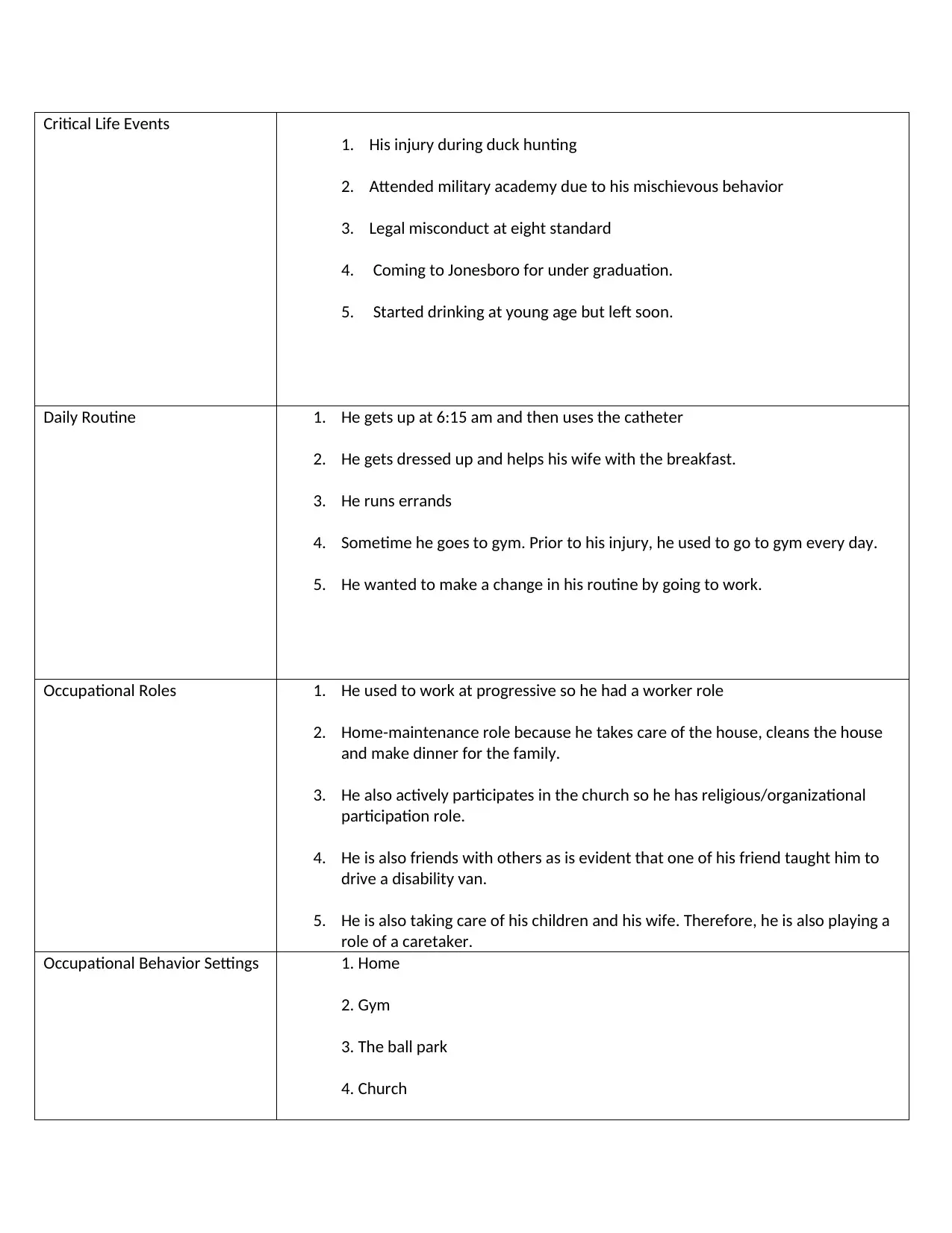
Critical Life Events
1. His injury during duck hunting
2. Attended military academy due to his mischievous behavior
3. Legal misconduct at eight standard
4. Coming to Jonesboro for under graduation.
5. Started drinking at young age but left soon.
Daily Routine 1. He gets up at 6:15 am and then uses the catheter
2. He gets dressed up and helps his wife with the breakfast.
3. He runs errands
4. Sometime he goes to gym. Prior to his injury, he used to go to gym every day.
5. He wanted to make a change in his routine by going to work.
Occupational Roles 1. He used to work at progressive so he had a worker role
2. Home-maintenance role because he takes care of the house, cleans the house
and make dinner for the family.
3. He also actively participates in the church so he has religious/organizational
participation role.
4. He is also friends with others as is evident that one of his friend taught him to
drive a disability van.
5. He is also taking care of his children and his wife. Therefore, he is also playing a
role of a caretaker.
Occupational Behavior Settings 1. Home
2. Gym
3. The ball park
4. Church
1. His injury during duck hunting
2. Attended military academy due to his mischievous behavior
3. Legal misconduct at eight standard
4. Coming to Jonesboro for under graduation.
5. Started drinking at young age but left soon.
Daily Routine 1. He gets up at 6:15 am and then uses the catheter
2. He gets dressed up and helps his wife with the breakfast.
3. He runs errands
4. Sometime he goes to gym. Prior to his injury, he used to go to gym every day.
5. He wanted to make a change in his routine by going to work.
Occupational Roles 1. He used to work at progressive so he had a worker role
2. Home-maintenance role because he takes care of the house, cleans the house
and make dinner for the family.
3. He also actively participates in the church so he has religious/organizational
participation role.
4. He is also friends with others as is evident that one of his friend taught him to
drive a disability van.
5. He is also taking care of his children and his wife. Therefore, he is also playing a
role of a caretaker.
Occupational Behavior Settings 1. Home
2. Gym
3. The ball park
4. Church
⊘ This is a preview!⊘
Do you want full access?
Subscribe today to unlock all pages.

Trusted by 1+ million students worldwide
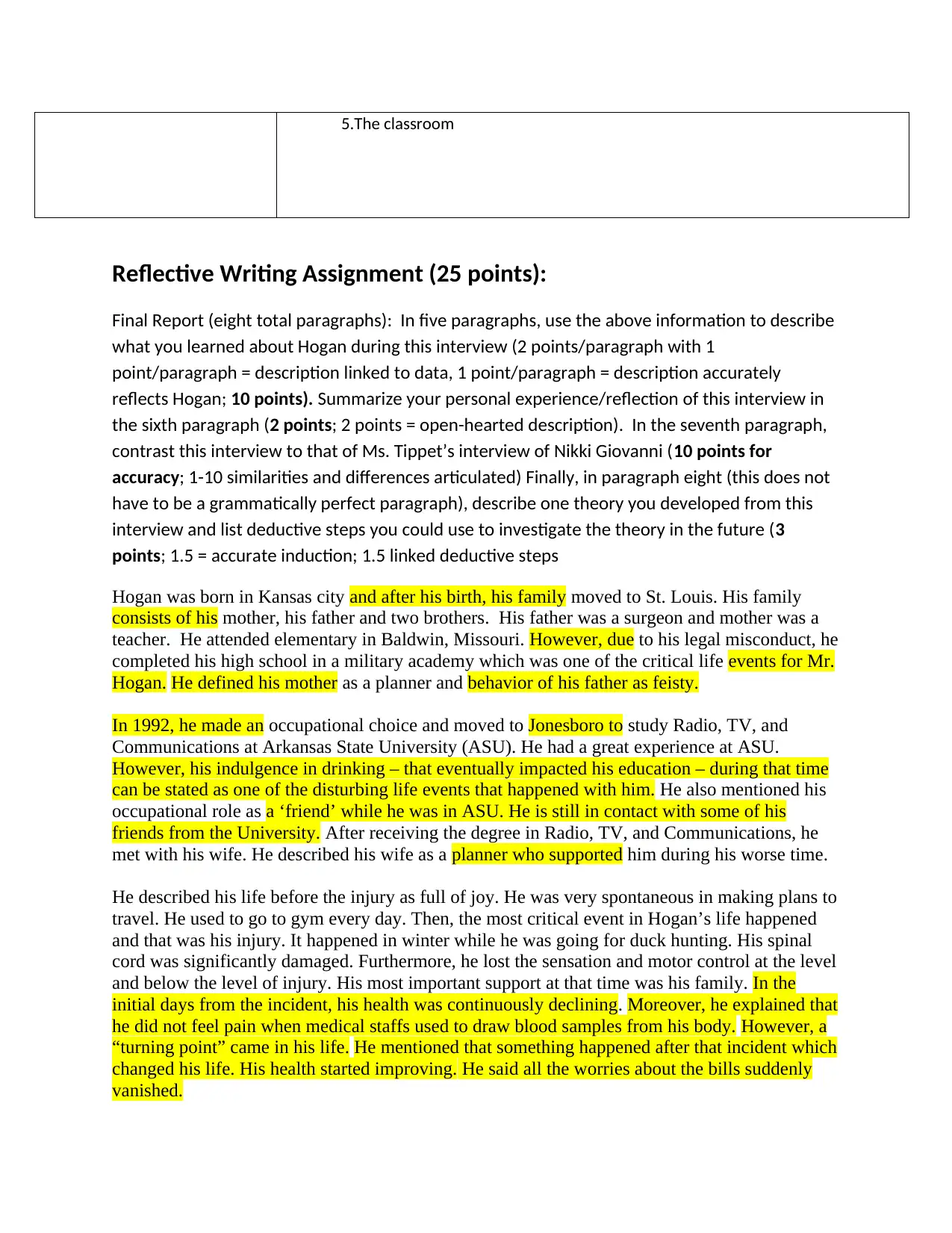
5.The classroom
Reflective Writing Assignment (25 points):
Final Report (eight total paragraphs): In five paragraphs, use the above information to describe
what you learned about Hogan during this interview (2 points/paragraph with 1
point/paragraph = description linked to data, 1 point/paragraph = description accurately
reflects Hogan; 10 points). Summarize your personal experience/reflection of this interview in
the sixth paragraph (2 points; 2 points = open-hearted description). In the seventh paragraph,
contrast this interview to that of Ms. Tippet’s interview of Nikki Giovanni (10 points for
accuracy; 1-10 similarities and differences articulated) Finally, in paragraph eight (this does not
have to be a grammatically perfect paragraph), describe one theory you developed from this
interview and list deductive steps you could use to investigate the theory in the future (3
points; 1.5 = accurate induction; 1.5 linked deductive steps
Hogan was born in Kansas city and after his birth, his family moved to St. Louis. His family
consists of his mother, his father and two brothers. His father was a surgeon and mother was a
teacher. He attended elementary in Baldwin, Missouri. However, due to his legal misconduct, he
completed his high school in a military academy which was one of the critical life events for Mr.
Hogan. He defined his mother as a planner and behavior of his father as feisty.
In 1992, he made an occupational choice and moved to Jonesboro to study Radio, TV, and
Communications at Arkansas State University (ASU). He had a great experience at ASU.
However, his indulgence in drinking – that eventually impacted his education – during that time
can be stated as one of the disturbing life events that happened with him. He also mentioned his
occupational role as a ‘friend’ while he was in ASU. He is still in contact with some of his
friends from the University. After receiving the degree in Radio, TV, and Communications, he
met with his wife. He described his wife as a planner who supported him during his worse time.
He described his life before the injury as full of joy. He was very spontaneous in making plans to
travel. He used to go to gym every day. Then, the most critical event in Hogan’s life happened
and that was his injury. It happened in winter while he was going for duck hunting. His spinal
cord was significantly damaged. Furthermore, he lost the sensation and motor control at the level
and below the level of injury. His most important support at that time was his family. In the
initial days from the incident, his health was continuously declining. Moreover, he explained that
he did not feel pain when medical staffs used to draw blood samples from his body. However, a
“turning point” came in his life. He mentioned that something happened after that incident which
changed his life. His health started improving. He said all the worries about the bills suddenly
vanished.
Reflective Writing Assignment (25 points):
Final Report (eight total paragraphs): In five paragraphs, use the above information to describe
what you learned about Hogan during this interview (2 points/paragraph with 1
point/paragraph = description linked to data, 1 point/paragraph = description accurately
reflects Hogan; 10 points). Summarize your personal experience/reflection of this interview in
the sixth paragraph (2 points; 2 points = open-hearted description). In the seventh paragraph,
contrast this interview to that of Ms. Tippet’s interview of Nikki Giovanni (10 points for
accuracy; 1-10 similarities and differences articulated) Finally, in paragraph eight (this does not
have to be a grammatically perfect paragraph), describe one theory you developed from this
interview and list deductive steps you could use to investigate the theory in the future (3
points; 1.5 = accurate induction; 1.5 linked deductive steps
Hogan was born in Kansas city and after his birth, his family moved to St. Louis. His family
consists of his mother, his father and two brothers. His father was a surgeon and mother was a
teacher. He attended elementary in Baldwin, Missouri. However, due to his legal misconduct, he
completed his high school in a military academy which was one of the critical life events for Mr.
Hogan. He defined his mother as a planner and behavior of his father as feisty.
In 1992, he made an occupational choice and moved to Jonesboro to study Radio, TV, and
Communications at Arkansas State University (ASU). He had a great experience at ASU.
However, his indulgence in drinking – that eventually impacted his education – during that time
can be stated as one of the disturbing life events that happened with him. He also mentioned his
occupational role as a ‘friend’ while he was in ASU. He is still in contact with some of his
friends from the University. After receiving the degree in Radio, TV, and Communications, he
met with his wife. He described his wife as a planner who supported him during his worse time.
He described his life before the injury as full of joy. He was very spontaneous in making plans to
travel. He used to go to gym every day. Then, the most critical event in Hogan’s life happened
and that was his injury. It happened in winter while he was going for duck hunting. His spinal
cord was significantly damaged. Furthermore, he lost the sensation and motor control at the level
and below the level of injury. His most important support at that time was his family. In the
initial days from the incident, his health was continuously declining. Moreover, he explained that
he did not feel pain when medical staffs used to draw blood samples from his body. However, a
“turning point” came in his life. He mentioned that something happened after that incident which
changed his life. His health started improving. He said all the worries about the bills suddenly
vanished.
Paraphrase This Document
Need a fresh take? Get an instant paraphrase of this document with our AI Paraphraser
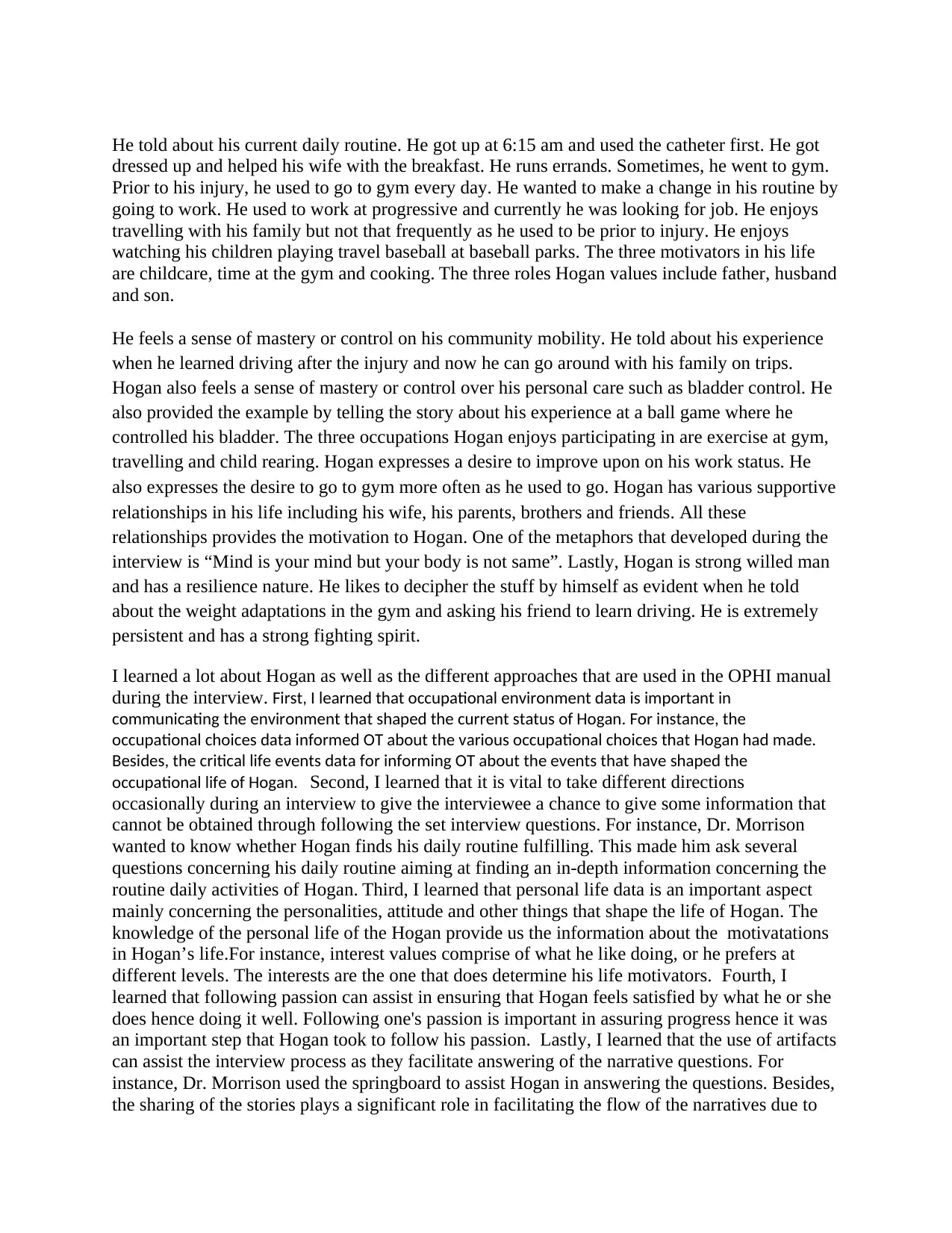
He told about his current daily routine. He got up at 6:15 am and used the catheter first. He got
dressed up and helped his wife with the breakfast. He runs errands. Sometimes, he went to gym.
Prior to his injury, he used to go to gym every day. He wanted to make a change in his routine by
going to work. He used to work at progressive and currently he was looking for job. He enjoys
travelling with his family but not that frequently as he used to be prior to injury. He enjoys
watching his children playing travel baseball at baseball parks. The three motivators in his life
are childcare, time at the gym and cooking. The three roles Hogan values include father, husband
and son.
He feels a sense of mastery or control on his community mobility. He told about his experience
when he learned driving after the injury and now he can go around with his family on trips.
Hogan also feels a sense of mastery or control over his personal care such as bladder control. He
also provided the example by telling the story about his experience at a ball game where he
controlled his bladder. The three occupations Hogan enjoys participating in are exercise at gym,
travelling and child rearing. Hogan expresses a desire to improve upon on his work status. He
also expresses the desire to go to gym more often as he used to go. Hogan has various supportive
relationships in his life including his wife, his parents, brothers and friends. All these
relationships provides the motivation to Hogan. One of the metaphors that developed during the
interview is “Mind is your mind but your body is not same”. Lastly, Hogan is strong willed man
and has a resilience nature. He likes to decipher the stuff by himself as evident when he told
about the weight adaptations in the gym and asking his friend to learn driving. He is extremely
persistent and has a strong fighting spirit.
I learned a lot about Hogan as well as the different approaches that are used in the OPHI manual
during the interview. First, I learned that occupational environment data is important in
communicating the environment that shaped the current status of Hogan. For instance, the
occupational choices data informed OT about the various occupational choices that Hogan had made.
Besides, the critical life events data for informing OT about the events that have shaped the
occupational life of Hogan. Second, I learned that it is vital to take different directions
occasionally during an interview to give the interviewee a chance to give some information that
cannot be obtained through following the set interview questions. For instance, Dr. Morrison
wanted to know whether Hogan finds his daily routine fulfilling. This made him ask several
questions concerning his daily routine aiming at finding an in-depth information concerning the
routine daily activities of Hogan. Third, I learned that personal life data is an important aspect
mainly concerning the personalities, attitude and other things that shape the life of Hogan. The
knowledge of the personal life of the Hogan provide us the information about the motivatations
in Hogan’s life.For instance, interest values comprise of what he like doing, or he prefers at
different levels. The interests are the one that does determine his life motivators. Fourth, I
learned that following passion can assist in ensuring that Hogan feels satisfied by what he or she
does hence doing it well. Following one's passion is important in assuring progress hence it was
an important step that Hogan took to follow his passion. Lastly, I learned that the use of artifacts
can assist the interview process as they facilitate answering of the narrative questions. For
instance, Dr. Morrison used the springboard to assist Hogan in answering the questions. Besides,
the sharing of the stories plays a significant role in facilitating the flow of the narratives due to
dressed up and helped his wife with the breakfast. He runs errands. Sometimes, he went to gym.
Prior to his injury, he used to go to gym every day. He wanted to make a change in his routine by
going to work. He used to work at progressive and currently he was looking for job. He enjoys
travelling with his family but not that frequently as he used to be prior to injury. He enjoys
watching his children playing travel baseball at baseball parks. The three motivators in his life
are childcare, time at the gym and cooking. The three roles Hogan values include father, husband
and son.
He feels a sense of mastery or control on his community mobility. He told about his experience
when he learned driving after the injury and now he can go around with his family on trips.
Hogan also feels a sense of mastery or control over his personal care such as bladder control. He
also provided the example by telling the story about his experience at a ball game where he
controlled his bladder. The three occupations Hogan enjoys participating in are exercise at gym,
travelling and child rearing. Hogan expresses a desire to improve upon on his work status. He
also expresses the desire to go to gym more often as he used to go. Hogan has various supportive
relationships in his life including his wife, his parents, brothers and friends. All these
relationships provides the motivation to Hogan. One of the metaphors that developed during the
interview is “Mind is your mind but your body is not same”. Lastly, Hogan is strong willed man
and has a resilience nature. He likes to decipher the stuff by himself as evident when he told
about the weight adaptations in the gym and asking his friend to learn driving. He is extremely
persistent and has a strong fighting spirit.
I learned a lot about Hogan as well as the different approaches that are used in the OPHI manual
during the interview. First, I learned that occupational environment data is important in
communicating the environment that shaped the current status of Hogan. For instance, the
occupational choices data informed OT about the various occupational choices that Hogan had made.
Besides, the critical life events data for informing OT about the events that have shaped the
occupational life of Hogan. Second, I learned that it is vital to take different directions
occasionally during an interview to give the interviewee a chance to give some information that
cannot be obtained through following the set interview questions. For instance, Dr. Morrison
wanted to know whether Hogan finds his daily routine fulfilling. This made him ask several
questions concerning his daily routine aiming at finding an in-depth information concerning the
routine daily activities of Hogan. Third, I learned that personal life data is an important aspect
mainly concerning the personalities, attitude and other things that shape the life of Hogan. The
knowledge of the personal life of the Hogan provide us the information about the motivatations
in Hogan’s life.For instance, interest values comprise of what he like doing, or he prefers at
different levels. The interests are the one that does determine his life motivators. Fourth, I
learned that following passion can assist in ensuring that Hogan feels satisfied by what he or she
does hence doing it well. Following one's passion is important in assuring progress hence it was
an important step that Hogan took to follow his passion. Lastly, I learned that the use of artifacts
can assist the interview process as they facilitate answering of the narrative questions. For
instance, Dr. Morrison used the springboard to assist Hogan in answering the questions. Besides,
the sharing of the stories plays a significant role in facilitating the flow of the narratives due to

the social relations established in the process of modeling narratives. The narratives can emerge
in the process of doing the interview where they are expected to reflect the interview intension.
Besides, the artifacts can assist in organizing the collection of information from the interviewer
in an orderly manner.
Differences Nikki’s Interview Hogan’s Interview
Interview Topic Nikki Giovanni interview was
about her life involving her
role as a revolutionary poet of
the Black Arts Movement that
nourished civil rights.
His interview was more
focused on his life before and
after injury.
Springboarding of interview Tippet used Nikki’s statement Dr. Morrison used the
Catheter to springboard the
interview
Interview Format File format
more rigid
Box format- flowchart
change directions
Food She loves food Hogan is usually very careful
with food due to his health
condition.
Experience Nikki had a previous
experience of giving interview
and she was very comfortable
during the interview.
I think Hogan had not that
much experience for giving
interview as Nikki.
Similarities
Beginning of the interview Starting with the name
change – Yolande to Nikki
Starting with the name
Germen word starts with C
passionate Nikki has a lot of passion for
her life.
Hogan also has a lot of
passion for his life
Travelling Nikki loves travelling Hogan likes travelling with
family.
Elaborate more approach
During the interview
This approach was used when
Tippet wanted to get more
information on her point of
view on slavery.
This approach was used when
Dr. Morrison took that
approach to encourage Mr.
Hogan to elaborate more on
his experience here at ASU so
that she knows more about his
experience when he started
drinking, about his friends,
and his environment.
in the process of doing the interview where they are expected to reflect the interview intension.
Besides, the artifacts can assist in organizing the collection of information from the interviewer
in an orderly manner.
Differences Nikki’s Interview Hogan’s Interview
Interview Topic Nikki Giovanni interview was
about her life involving her
role as a revolutionary poet of
the Black Arts Movement that
nourished civil rights.
His interview was more
focused on his life before and
after injury.
Springboarding of interview Tippet used Nikki’s statement Dr. Morrison used the
Catheter to springboard the
interview
Interview Format File format
more rigid
Box format- flowchart
change directions
Food She loves food Hogan is usually very careful
with food due to his health
condition.
Experience Nikki had a previous
experience of giving interview
and she was very comfortable
during the interview.
I think Hogan had not that
much experience for giving
interview as Nikki.
Similarities
Beginning of the interview Starting with the name
change – Yolande to Nikki
Starting with the name
Germen word starts with C
passionate Nikki has a lot of passion for
her life.
Hogan also has a lot of
passion for his life
Travelling Nikki loves travelling Hogan likes travelling with
family.
Elaborate more approach
During the interview
This approach was used when
Tippet wanted to get more
information on her point of
view on slavery.
This approach was used when
Dr. Morrison took that
approach to encourage Mr.
Hogan to elaborate more on
his experience here at ASU so
that she knows more about his
experience when he started
drinking, about his friends,
and his environment.
⊘ This is a preview!⊘
Do you want full access?
Subscribe today to unlock all pages.

Trusted by 1+ million students worldwide
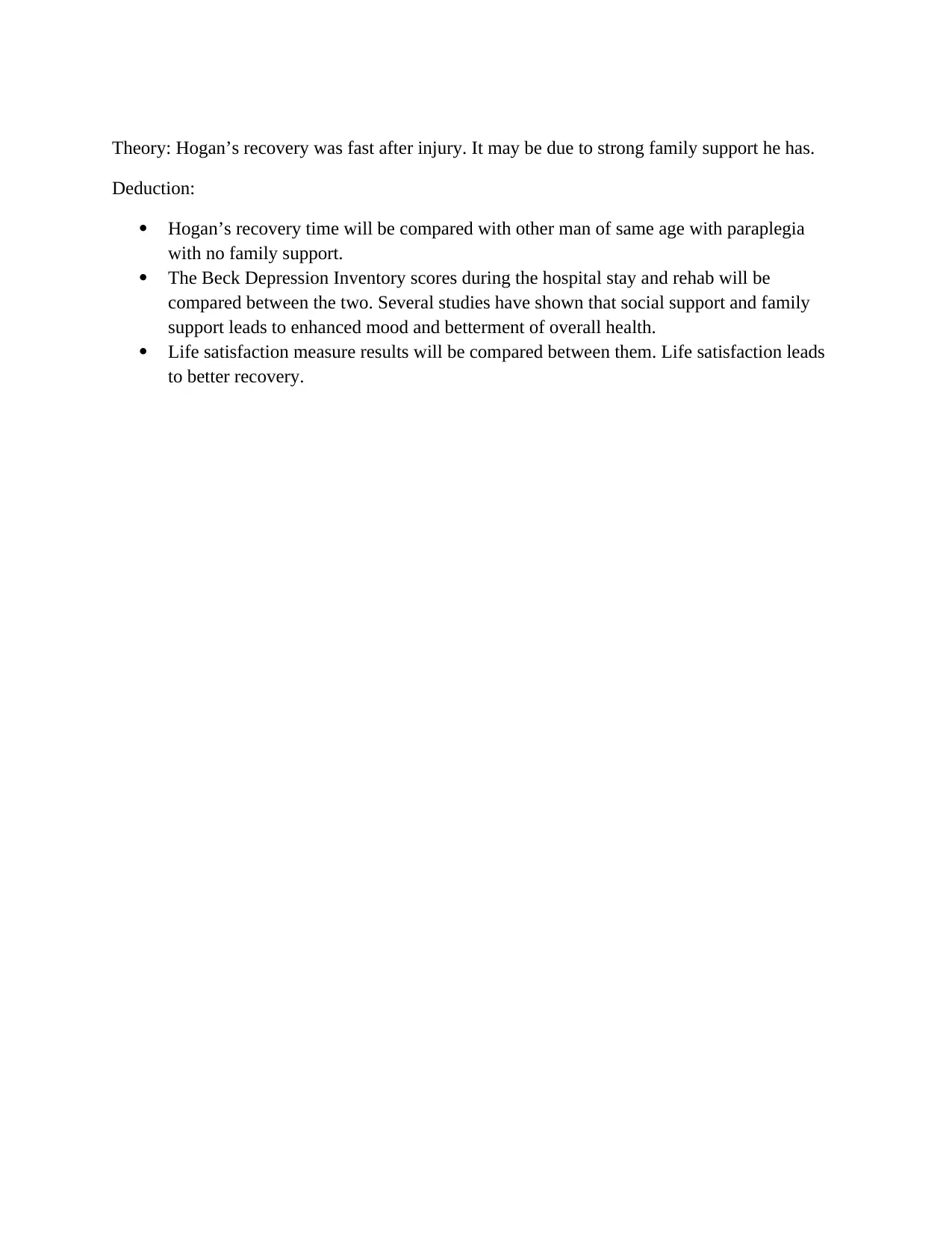
Theory: Hogan’s recovery was fast after injury. It may be due to strong family support he has.
Deduction:
Hogan’s recovery time will be compared with other man of same age with paraplegia
with no family support.
The Beck Depression Inventory scores during the hospital stay and rehab will be
compared between the two. Several studies have shown that social support and family
support leads to enhanced mood and betterment of overall health.
Life satisfaction measure results will be compared between them. Life satisfaction leads
to better recovery.
Deduction:
Hogan’s recovery time will be compared with other man of same age with paraplegia
with no family support.
The Beck Depression Inventory scores during the hospital stay and rehab will be
compared between the two. Several studies have shown that social support and family
support leads to enhanced mood and betterment of overall health.
Life satisfaction measure results will be compared between them. Life satisfaction leads
to better recovery.
1 out of 7
Your All-in-One AI-Powered Toolkit for Academic Success.
+13062052269
info@desklib.com
Available 24*7 on WhatsApp / Email
![[object Object]](/_next/static/media/star-bottom.7253800d.svg)
Unlock your academic potential
Copyright © 2020–2025 A2Z Services. All Rights Reserved. Developed and managed by ZUCOL.